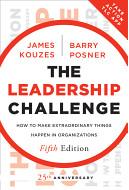Introduction
The Leadership Challenge written by James Kouzes and Barry Posner has become a leadership classic. First written in 1987, it has gone through five editions and marked its 25th anniversary when the 5th edition was published in 2012. The book has sold more than 2 million copies and translated into 20 languages. It focuses on five practices that the authors believe lead to exemplary leadership. These five practices are, model the way, inspire a shared vision, challenge the process, enable others to act, and encourage the heart. The authors have spent more than 3 decades teaching and researching on leadership and through that time have continued to talk to people in different types of organizations to find out about what makes effective leadership. One question they have been asking since 1982 when they started focusing on leadership is: What did you do when you were at your personal best as a leader? The compilation of what they have observed in their research and studies of people is what culminated in the the five exemplary practices.
Kouzes and Posner have put a lot into this work, the book is accompanied by an app which you can get at the app store, unfortunately there is no android or windows version of the app. There is an online Leadership Practices Inventory (LPI) which generates about 500,00 to 750,000 responses annually. The data from the LPI is continually used to develop the five practices. I have to say, this is a big book, spanning 394 pages, but an interesting one to read. The language is easy and it contains numerous stories of leadership in practice. The book has:
- An introduction
- 12 chapters of content
- A lot of notes about references used
- Acknowledgements
- A bit about the authors
The book is divided into five parts based on the five leadership practices. Each part has two chapters dealing with a practice. There is one chapter before the practices are explained and another to conclude the book. The five practices consist of what the authors call ten commitments. Each practice has two commitments so the ten chapters covering the practices concentrate on the ten commitments. Apart from the first and last chapters all other chapters are structured in a consistent way. Each of the ten chapters dealing with the practices has content explaining the practice and advice on how to put the practice into action. Following is a brief overview of each chapter.
Chapter One - When Leaders Are At Their Best: This is an introduction to the five practices and ten commitments. It has some great stories and outlines some research supporting the five practices. It has a section which discusses what people look for in their leaders which invariably concludes that credibility is the foundation for effective leadership. It also describes leadership as a relationship. Just reading this chapter will give you a good overview of the five chapters.
Chapter Two - Clarify Values: The first practice covered is Model The Way and so this chapter is about the first of the commitments under that practice. The commitment is, clarify values by finding your voice and affirming shared values. In explaining the model the way practice, just before the chapter begins the authors write that, "The first step a leader must take along the path to becoming an exemplary leader is inward. It's a step towards discovering personal values and beliefs. Leaders must find their voice. Leaders must be able to define who they are in an authentic way and be clear about what they believe. But they must go further by also affirming the values of those they lead. Using stories, topics such as let your values guide you, give people reasons to care and forge unity, don't force it are discussed. The chapter ends with some advice on how to put this commitment into action. One piece of advice given is, examine your past experiences to identify the values you use to make choices and decisions.
Chapter Three - Set The Example: This chapter covers the second commitment under model the way. The commitment expresses that: set the example by aligning actions with shared values. A story is used to open the chapter as a way to illustrate what set the example in real life looks like, and there are actions necessary to set the example as explained by the authors which are live the shared values and teach others to live the shared values.
Chapter Four - Envision The Future: The second practice, Inspire a Shared Vision has these two commitments, envision the future by imagining exciting and ennobling possibilities and enlist others by appealing to shared aspirations. This chapter deals with the first one. It affirms that to live out the commitment leaders have to imagine the possibilities and find a common purpose. Advice given to live out this commitment include:
- determining what you care about, what drives you, where your passions lie
- involve others in crafting what could be possible, don't make it a top-down process
- get people on the same page, the same path, about where you are going
Chapter Five - Enlist Others: The second commitment under inspire a shared vision is covered here and it is about involving others to be part of a vision. The authors believe that for leaders to do this they must appeal to common ideals and animate the vision. Advice given to do this include talking to constituents to find out what their hopes, dreams and aspirations for the future are and showing constituents how their long-term interests are served by enlisting in a common vision. Look out for some more great stories and examples in this chapter.
Chapter Six - Search For Opportunities: Challenge the Process is the next of the practices dealt with and this chapter covers the first commitment under that practice. The authors introduce challenge the process this way: challenge is the opportunity for greatness. People do their best when there's the chance to change the way things are. Challenge the process is about progress, innovation and making changes. The two commitments required for this practice are, search for opportunities by seizing the initiative and looking outward for innovative ways to improve and experiment and take risks by constantly generating small wins and learning from experience. Leaders who practice the first commitment do so by seizing the initiative and exercising outsight (keep learning and stay ahead of the changes in your environment). Part of the advice given to do this is to always ask, what's new?, what's next?, what's better? And to do something each day so that you are better than you were the day before.
Chapter Seven - Experiment and Take Risks: This chapter deals with the second commitment under Challenge the Process and it has two actions which are generate small wins and learn from experience. Learn from experience is quite interesting and is an important leadership feature. The importance of developing learning agility defined as, the ability to reflect on experience and then engage in new behaviors based on the reflections, is discussed. Some advice given for living out this commitment are, emphasize how personal fulfillment results from constantly challenging oneself to improve and spend time learning something relevant and new everyday and offer that opportunity to your constituents.
Chapter Eight - Foster Collaboration: This chapter introduces the fourth practice, Enable others to Act, and discusses the first commitment under the practice which is, foster collaboration by building trust and facilitating relationships. This practice is all about how leaders develop productive relationships which enable them to work with people successfully to achieve outcomes effectively. Fostering collaboration entails creating an environment of trust and facilitating relationships. According to the authors doing this may involve the leader being the first to trust, showing concern for others, sharing information and knowledge, developing cooperative goals and roles, and supporting face to face interactions.
Chapter Nine - Strengthen Others: The second commitment under Enable others to Act is, strengthen others by increasing self-determination and developing competence. On this commitment the leaders imply that, exemplary leaders build an environment that develops both people's abilities to perform a task and their self-confidence. For leaders to strengthen others they must enhance people's self determination and help them develop competence and confidence. How leaders can do this is discussed in this chapter and some advice given are to structure jobs so that people have opportunities to use their judgement, provide necessary resources to perform effectively and educate yourself and your constituents.
Chapter Ten - Recognize Contributions: The final practice is Encourage The Heart, which is about the leader encouraging and inspiring others, giving them hope and courage and visibly recognizing people's contributions. The first commitment dealt with in this chapter is, recognize contributions by showing appreciation for individual excellence. Leaders can recognize people's contributions by expecting the best from them and personalizing recognition. Some actions that can help to do this are showing people you believe in them, giving regular feedback, getting close to people and just saying thank you.
Chapter Eleven - Celebrate The Values and Victories: The second commitment under Encourage The Heart and last for the five practices deals with celebrating people and their efforts. According to the authors, when leaders bring people together, rejoice in collective successes, and directly display their gratitude, they reinforce the essence of community. Two actions are suggested to live out this commitment, create a spirit of community and be personally involved. Celebrating victories in public, investing in fun, showing you care and spreading stories are all aspects of celebrating victory.
Chapter Twelve - Leadership is Everyone's Business: This is the final chapter and in concluding the authors emphasize some important points. First of all they make it known that leadership is not just found at the top of organizations, it is everywhere. Secondly people watch those who lead whether they know it or not, as a result they must be mindful of how important they are. Next is the fact that leadership can be learned, according to the authors, it's an observable pattern of practices and behaviors and a definable set of skills and abilities. Also is the fact that given the challenges of leadership, leaders must remain humble and human. The book ends with an intriguing section titled, remember the secret to success in life. So what is the secret to success in life? A question no doubt all of us want an answer to. The answer as defined here may surprise you, it's "staying in love". Yes you read that right, staying in love with leading. This is a trait the authors express is present in most of the leaders they have researched over the years. And their final statement as they close the book is interesting too. This is it:
Leadership is not an affair of the head. Leadership is an affair of the heart.
Reading this book for me has been quite an experience. Personally it clarifies the fact that anybody can lead, off course in specific areas. Therefore leadership is not the reserved gift for some, it is accessible to all. The stories in the book, and there are many of them, give leadership a living face. This is not a book of models and theories, rather it is based on accounts of how people have led in various ways. I would definitely recommend you read it if you have the opportunity.










